My Experience With RRP
I am putting this on the web in the hope that it
will
help others with this problem. If you have any questions you are
welcome to contact me at: tony@lekas.org
There are two web sites containing information on
rrp.
See:
RRP Foundation
The RRP Web Site
I first noticed a problem with my voice late spring
2001.
It gradually grew worse and I went to see my primary care doctor who
referred
me to a local ENT. The ENT said that I had polyps and that they
might
be due to acid reflux. He put me on Prilosec for a month.
This
did not help. He then scheduled me for surgery. At this
point
I knew nothing about rrp and the ENT said that sometimes these polyps
just
happen. I had my first surgery 1/3/2002. I do not know what
he used
to remove the polyps. I was only told to rest my voice for a few
days. My voice got somewhat better and then quickly back to where
it was. I went back for a checkup after 2 weeks. The doctor
told me that he had not been able to remove all of the polyps without
risking
damage to my vocal cords. He had left a thin layer. He
referred
me to Dr Zeitels at Mass Eye & Ear Infirmary in Boston. I had
a fight with my insurance company to get an out of network
referral.
Eventually I did get it. I will have different insurance starting
January.
This is an image from my first examination with Dr
Zeitels
on 3/20/2002. Note the papilloma on my left vocal fold.
Also
note that it is spreading down towards where the vocal folds
join.
Dr Zeitels said that he was almost certain it was rrp. He
explained
the disease and referred me to the RRP Foundation at
http://www.rrpf.org/
He recommended surgery. After another insurance fight I got it
scheduled.
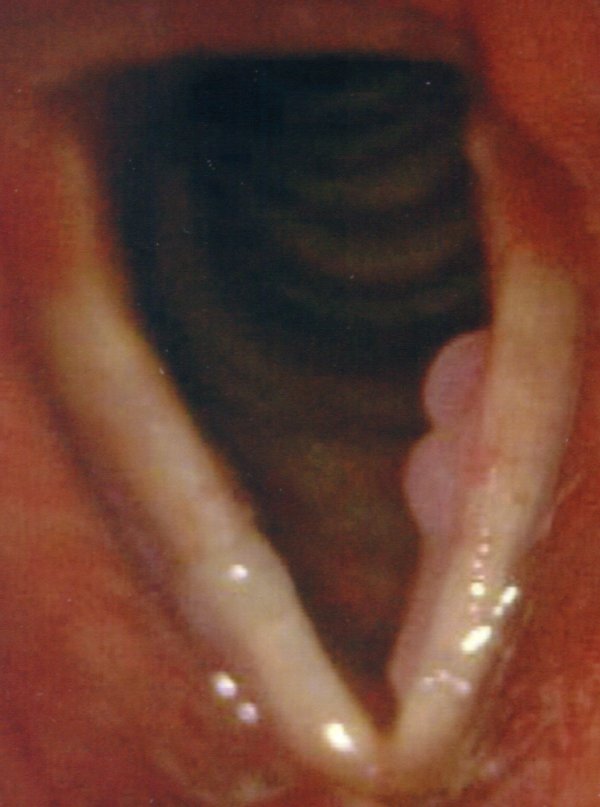
The next image was taken during my surgery on
6/10/2002,
3 months after the one above. This was taken through a
microscope.
Note that the papilloma appears to have spread down to where the vocal
folds joined. I have seen other pictures taken during surgery of
other parts of the papilloma. All of it grew a great deal during
the 3 months. He used a combination of cold steel and a Tuned
Pulse
Dye Laser (PDL). (There is a description of the PDL further on.)
Surgeries Under General
Anesthesia: 2
Surgeries Under Local Anesthesia: 0
Interval Since Last Surgery: 22 Weeks
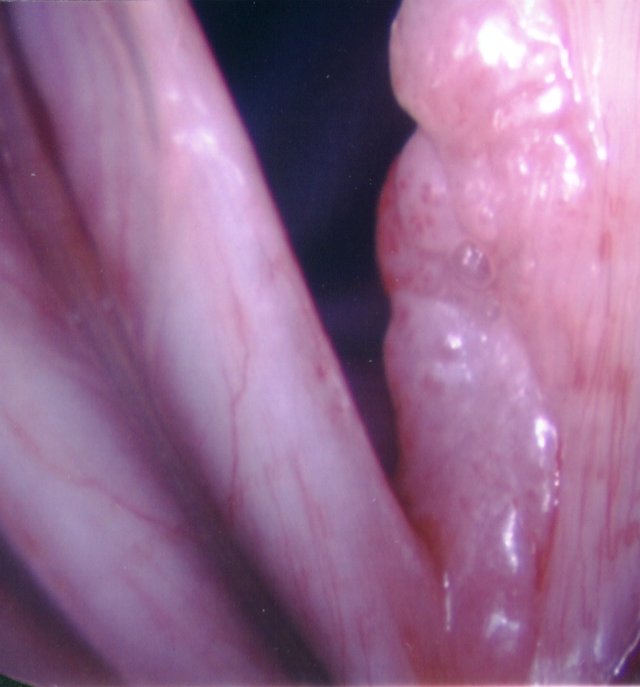
The next image was taken about 2 weeks after surgery
on 6/26/2002. The left vocal fold is still somewhat red and
swollen
but the surface looks good except for the lump towards the
center.
The doctor said that this was almost certainly a granuloma but there
was
some possibility that the papilloma was growing back. He said
that
it might or might not shrink.
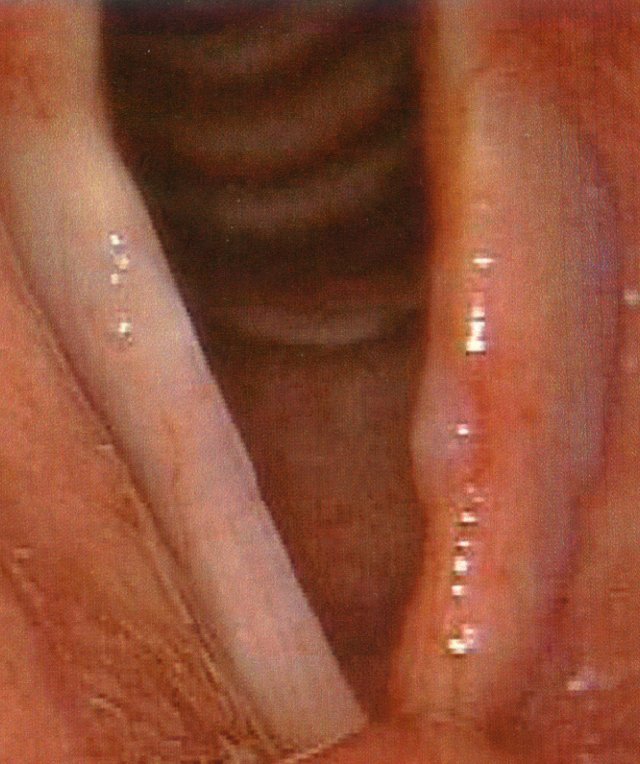
The next image was taken 1 month after surgery on
7/10/2002.
As you can see the lump did not go away. The doctor said that
this
was clearly a granuloma. It was firm which was easier to see in
the
video when it came into contact with the other vocal fold. He
said
that papilloma is softer. This will cause problems with my
speech.
He was also concerned that it would damage the other vocal fold.
I will have to have surgery in about 2 weeks to get it removed.
More
pictures when I get them.
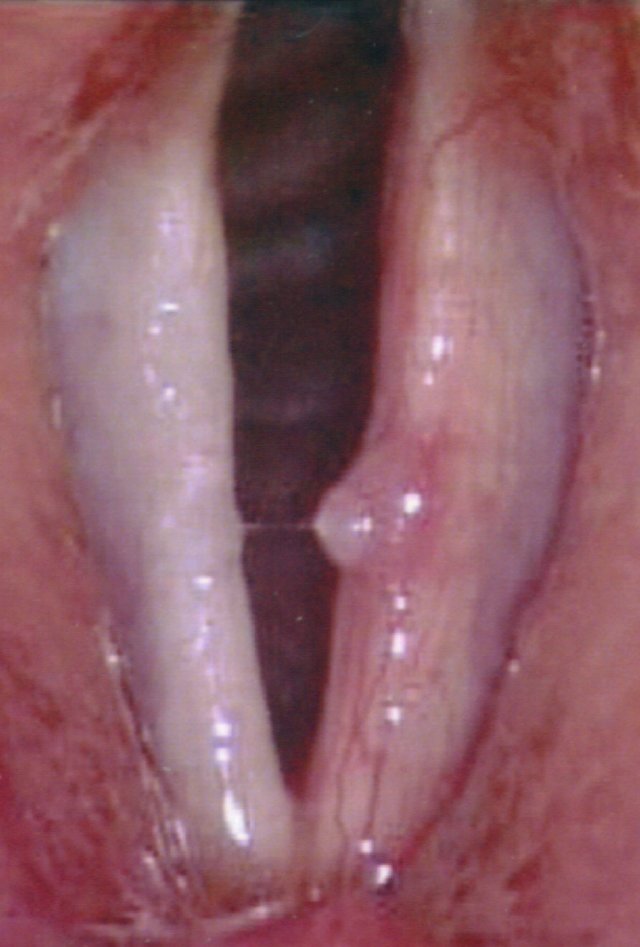
I had surgery again on 7/25/2002. I did not get
any photos from the surgery this time. He removed the granuloma
and
a small amount of papilloma that grew back.
Surgeries Under General
Anesthesia: 3
Surgeries Under Local
Anesthesia: 0
Interval Since Last Surgery: 7 Weeks
I had a checkup about two weeks later and was told
that
I was completely clear of papilloma. This exam was done with a
flexible
scope through the nose and no pictures were taken. I had several
sessions with a speech therapist and my voice ended sounding the same
as
it did before this whole thing started! The only difference I
noticed
was that I could not yell as loud as I used to. Of course I was
told
that yelling was not a good thing to do. I am sometimes in
situations
where I have to communicate with someone when there is high background
noise.
I went for a checkup on 11/6/2002. This was
somewhat
later than planned due to Dr Zeitels schedule. He told me that
the
papilloma had returned and that I needed to have it removed
again.
This was about 15 weeks since the last surgery.
This time Dr Zeitels recommended that I have the
papilloma
removed using just the Tuned Pulse Dye Laser (PDL) under local
anesthesia.
He referred me to Dr Franco to have this done. Dr Franco works
with
Dr Zeitels at Mass Eye & Ear Infirmary and has been doing this
procedure
for 2-3 years. I went in to see Dr Franco on 11/19/2002. He
explained that the PDL was tuned to a wavelength that is preferentially
absorbed by blood. It is used to coagulate the blood supply to
the
papilloma. They then slough off of the vocal cords. It
cannot
be used if the papilloma is too large because it can only penetrate so
far. Here is the before image on 11/19/2002. The resolution
is not as good as the previous images because this one was taken with a
flexible scope through the nose rather than a rigid one through the
mouth.
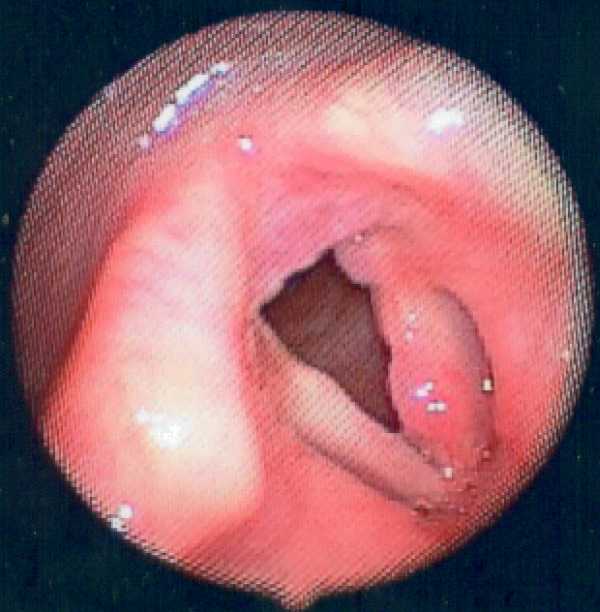
PDL Procedure
-I was seated in an exam chair.
-First he sprayed an anesthetic and decongestant
through
my right nostril. He also sprayed the same anesthetic that is
used
for the rigid scope down my throat. This was followed by spraying
lidocane down my throat while I was told to pant quickly. I have
a very active gag reflex and I kept gagging as the lidocane was
sprayed.
This probably led to some later problems.
-A thin tube connected to suction was run down my
other
nostril. I was given goggles to protect my eyes.
-A flexible scope was run down my right
nostril.
It was somewhat thicker then the ones normally used for exams. It
had an opening down the middle. A suction tube was connected near
the part the doctor held, with a valve that he controlled. A
thin,
clear optical fiber was also run into the handle area of the
scope.
He pushed it into the scope and could control the amount that extended
beyond the end of the scope.
-He would then manipulate the scope and fiber to aim
it
at the papillomas. When in place he used, I believe, a foot pedal
to turn it on. I could hear it pulse between 1-2 times per second
and I could see the pulses in the fiber. The light appeared to be
a pinkish color. During this I was told to breath in and
out.
There was some smell of burning but it was not too bad.
-At times I did have some problems with pain, at one
point
bad enough that he had to stop and spray more lidocane in. Even
after
that I had some significant pain. After the procedure we
"discussed"
this. If I have to have this done again I will probably get a lot
more of the initial spray down the throat and then wait a while before
trying the lidocane. This helped with the rigid scope in the
past.
The gagging probably prevented the lidocane from getting everywhere it
needed to.
-He needed to use about 725 pulses. He had
told
me before he started that the length of voice rest would depend on how
many pulses were used. The laser causes bruising in the vocal
cords.
I was told not to speak at all for 7 days. If I had had less
papilloma
and only about 100 pulses were required the voice rest would have been
2-3 days.
After the procedure he showed me parts of the video
on
the computer. If you look at the upper part of the left vocal
cord
in the image above (the one to the right in the image) you will see a
distinct
lump. After using the laser on the base of it he was able to use
the scope to push it off. He then had me cough it up so I could
swallow.
The picture below was taken at the end of the
procedure.
As you can see the lump mentioned above is gone. There is a white
area where it was. However the more spread out papilloma is a
bruised
mess that is still attached. It is hard to imagine that the
result
will be a clean vocal cord but that is what is supposed to
happen.
I will go back in 2-3 weeks and will see how it turned out.
The reason for doing this under local is because of
the
risk of repeated general anesthesia. Also the entire procedure
took
around 15 minutes after things were setup. Afterwards I just left
and got a ride home. All I had was a sore throat that almost
entirely
went away by the next day. If this works well and my voice comes
back it will be a great improvement over surgery.
Surgeries Under General
Anesthesia: 3
Surgeries Under Local
Anesthesia: 1
Interval
Since Last Surgery: 17 Weeks
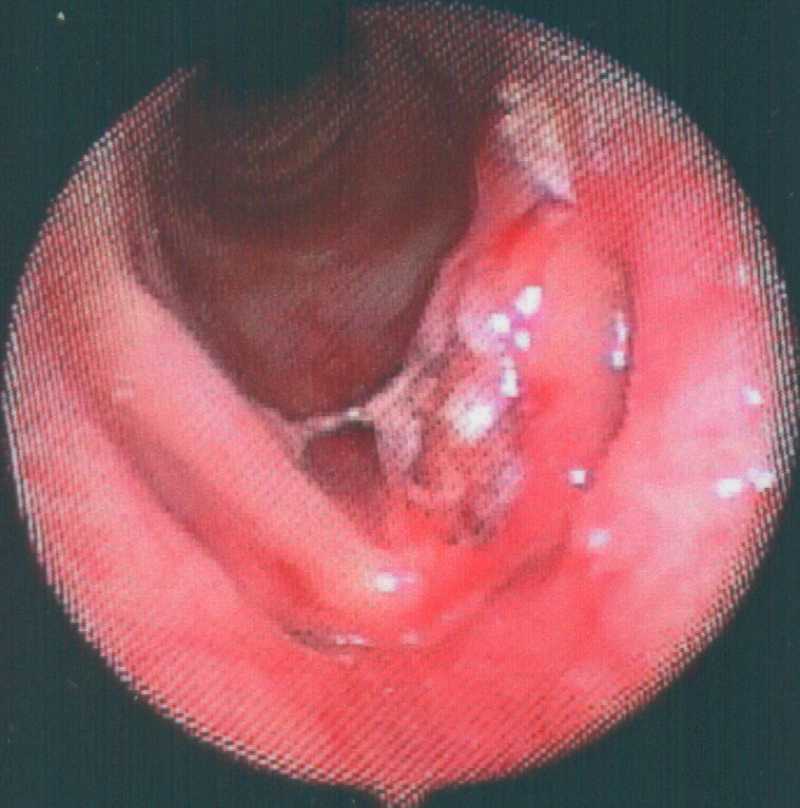
I went back for a checkup on 12/13/02, after the PDL
treatment.
My voice had not come back as well as I had hoped. I also had a
bit
of a sore throat almost up to the date of my checkup. Dr Franco
said
that the PDL treatment causes some blood vessel damage in the vocal
fold.
If I am rough on the vocal fold it is more likely that there will be
bleeding
inside of the vocal fold that will cause swelling. The day after
the 7 days of voice rest I was visiting with friends over
Thanksgiving.
Over the 4-5 days I was probably taking much more than I should
have.
In large groups I was trying to speak louder than I should. This
may have delayed the healing. Dr Franco said that the lump at the
upper right in the photo appears to be a granuloma that may be caused
by
irritation that resulted from overusing my voice. He also said
that
in the future it would be better to get me in for the PDL treatment
before
there was as much re-growth. When there are fewer laser pulses
used
the recovery is quicker and there is less chance of problems such as
this.
He also commented that the fold was redder and more
swollen
than he expected. I then told him that I had inhaled a bit of
food
that morning and had to cough repeatedly and vigorously to get it
up.
He said that could have been the cause. I am supposed to not
speak
any louder than I can comfortably. I will have another checkup in
about 6 weeks.
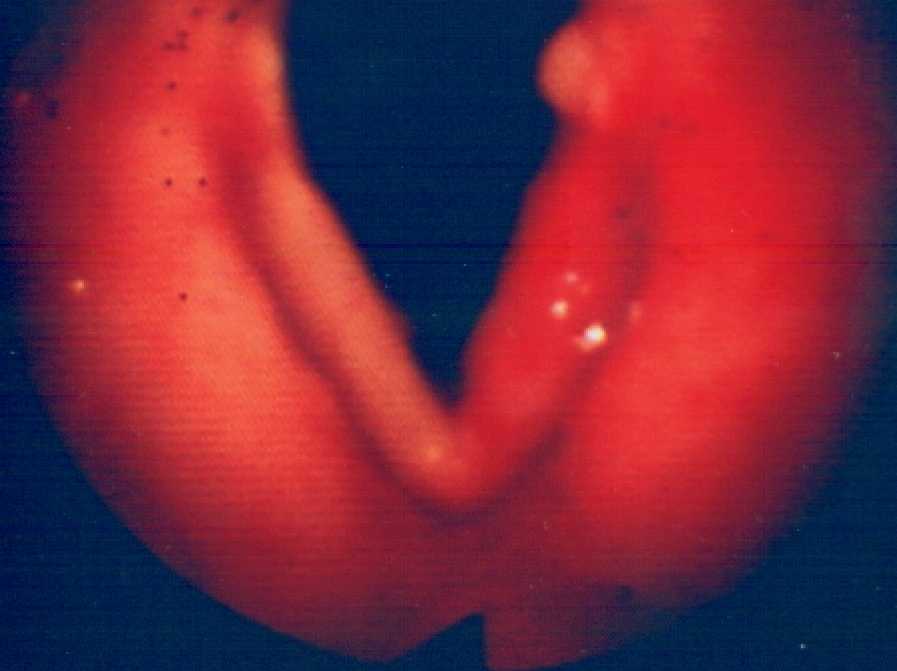
Towards the end of December 2002 my voice almost
returned
to normal. I was pleasantly surprised. After seeing the
pictures
during surgery and after my slow recovery I was somewhat skeptical
about
my voice recovering. The pulsed dye laser works!
I went in for another checkup on 1/27/03. The
picture
below was taken at that visit. I had significant re-growth of the
papilloma. Much of my left vocal fold, on the right in the
picture,
is completely covered with a smooth layer of papilloma. There is
a small lump towards the bottom and larger ones near the top.
I was also disturbed to see a small pap on my right
vocal
fold. It showed up better on the screen than in this scan of the
photo. This is the first time that the right one has been
involved.
At this point the effect on my voice was
minor.
The part of the vocal fold furthest away from where the folds join has
less effect on the voice. The other parts have a fairly smooth
layer.
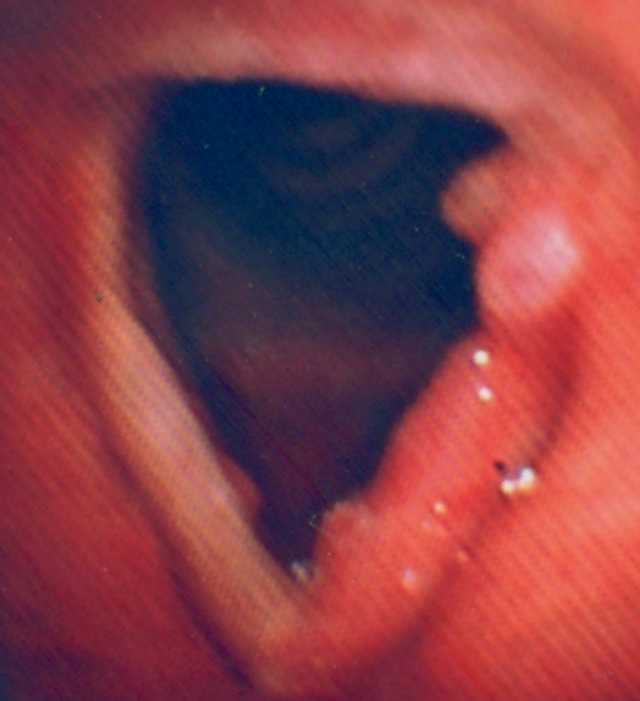
I am scheduled to go back on 2/6/03. Dr Franco
plans
to do Cidofovir injections in all of the places where I have
papillomas.
He will then use the pulse dye laser to remove the papillomas.
This
will all be done under local anesthesia.
On 2/6/03 I went in again for treatment. No
pictures
this time. First under local anesthesia I was given Cidofovir
injections.
This was done with a large curved needle through my mouth guided by a
flexible
scope through my nose. These injections were done through the
papillomas
into my vocal folds. After this the papilloma were treated with
the
Pulse Dye Laser. I am on voice rest till 2/12 and I have a
checkup
schedule for 2/28.
I still had difficulties with the effectiveness of
the
local anesthetic. During some of the injections and some portions
of the laser treatment I experienced significant pain. The
problem
was not just the pain but my inability to control my gag reflex when
experiencing
it. I will discuss how to deal with this in the future with the
doctor
when I have the checkup.
Surgeries
Under General Anesthesia: 3
Surgeries
Under Local Anesthesia: 2
Interval
Since Last Surgery: 11 Weeks
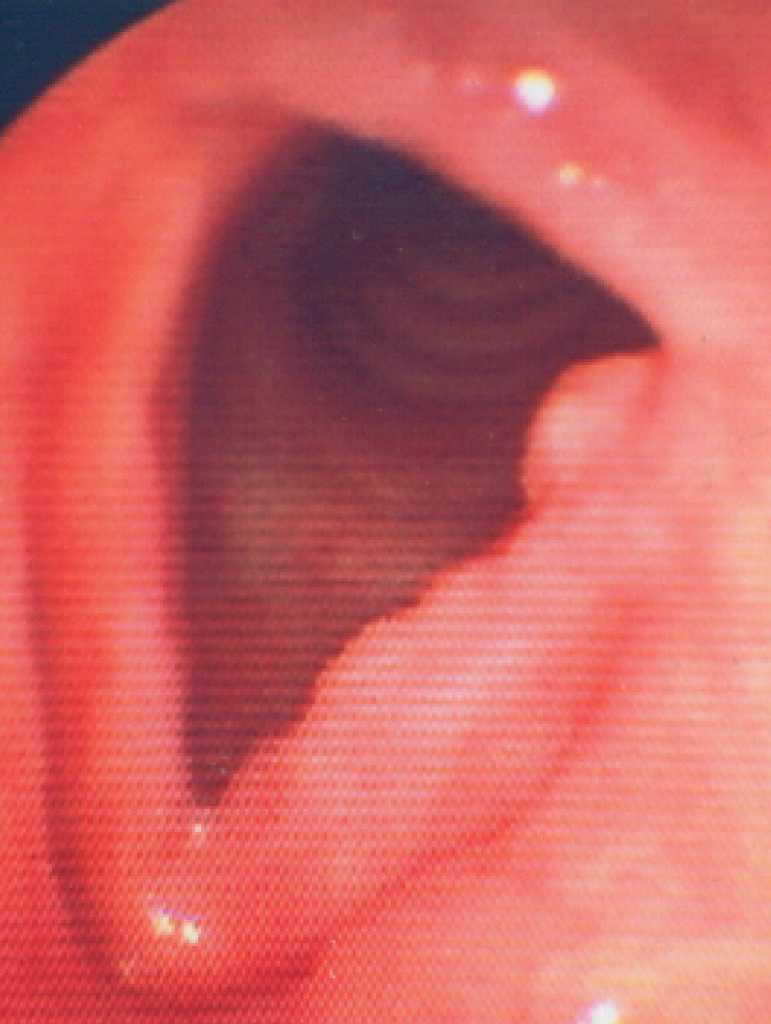
On 2/28/03 I went back in for a checkup. This
was
about 3 weeks after I was treated with Cidofovir injections and with
the
PDL. As you can see, my left vocal fold is covered with
papilloma.
The doctor said that this is new growth since the treatment! We
discussed
what to do about this. One option would be to go in for surgery
with
general anesthesia. This would allow the doctor to do a better
job
of cleaning all of the papilloma off. The other option would be
to
go in again for another series of Cidofovir injections and another
treatment
with the PDL under local anesthesia. His recommendation was to
try
the PDL again. He said that sometimes it takes a few treatments
before
the rate of reoccurrence goes down when using the PDL. He did not
know why that was. I decided to try the PDL with local anesthesia
and I am scheduled for that treatment on 3/6/03.
I also discussed the problems I had with the local
anesthesia
not working. He said that part of the problem is that the area
where
the large lump is, near the wide opening, does not get good coverage
when
the Lidocane is inhaled. He offered two options. The first
would be to take some Valium an hour before the treatment. He
said
that along with the usual local anesthesia it would help me control the
gagging. The second option would be to get an injection in the
neck
which would completely eliminate all feeling. That would last for
2-3 hours. I will try the Valium for the next treatment.
On 3/6/03 I went back in for treatment. The
papilloma
were injected with Cidofovir and the PDL was used on them. I
still
had problems with the local anesthesia. The Valium was completely
useless. If anything it made it a little more difficult to
intentionally
relax and ignore what was going on. I took 4 mg and I weigh about
245#. The doctor was able to inject all of the papilloma,
including
the large lump at the top of my left vocal fold with Cidofovir.
The
injections in the lump were painful but I was able to control it.
However, any attempt to use the laser on the lump caused enough pain
that
I gagged uncontrollably. The doctor expressed the hope that
because
he was able to thoroughly inject it the Cidofovir may help. The
problem
seems to be that panting while lidocane is being sprayed down my throat
does not get to the upper area of the vocal folds. I am on voice
rest for 5 days and I will have a checkup in about 2 weeks.
Surgeries Under General
Anesthesia: 3
Surgeries Under Local Anesthesia: 3
Interval
Since Last Surgery: 4 Weeks
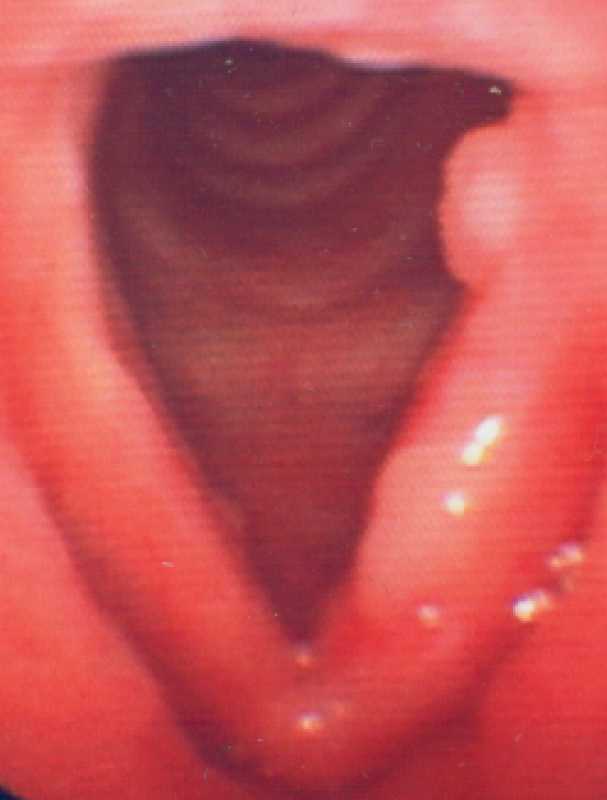
On 3/21 I went back for a checkup. The doctor
said
that the material on my left vocal fold is probably papilloma which is
dead but has not yet sloughed off. It is white and papilloma
normally
redder because it has lots of capillaries in it. I have a checkup
in another 3 weeks. My voice is reasonably close to normal.
Dr Franco also said that he met with Dr Rosen and Dr
Rosen
may be getting PDL equipment for treating rrp.
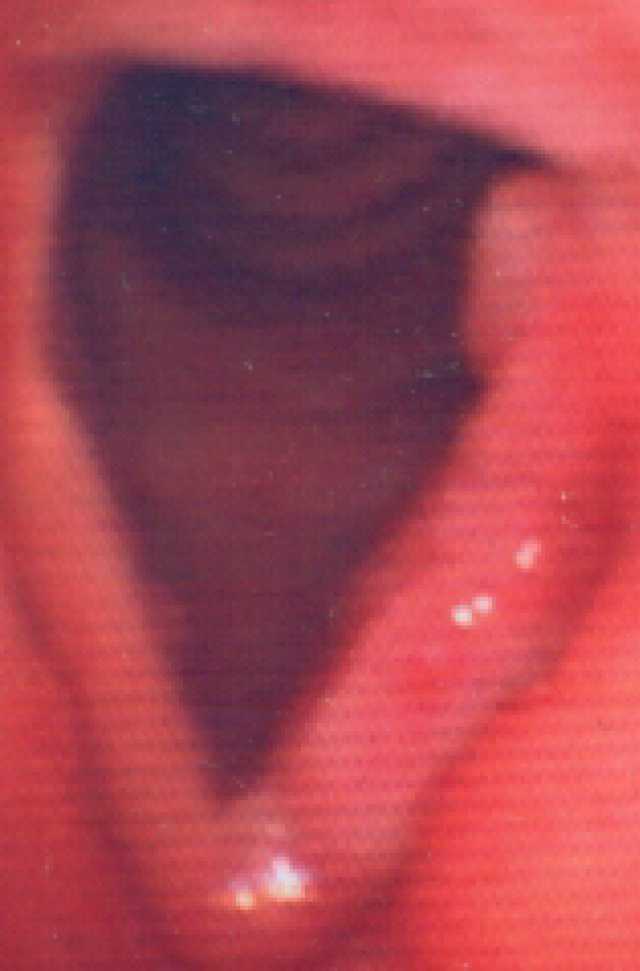
On 4/18/03 I went back in for a checkup. As you
can see there is still material on my left vocal fold. Dr Franco
said that the lump near the top should not effect my voice much.
He was unable to treat it much with the laser because the local
anesthesia
did not get to that area well enough. I am writing this on 5/14
and
so far my voice, while not perfect, is doing reasonably well. I
go
back for a checkup on 5/30.
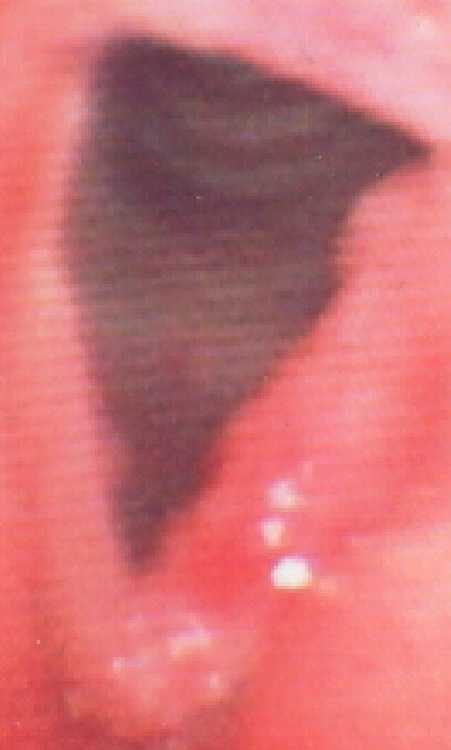
On 5/30/03 I went back for a checkup. Except for
the large lump at the top of my left vocal fold there has been little
if
any change. The lump has become smaller. My voice is not
perfect
but it is quite usable. I will continue to take 750 mg DIM per
day
and I have a checkup on 8/4.
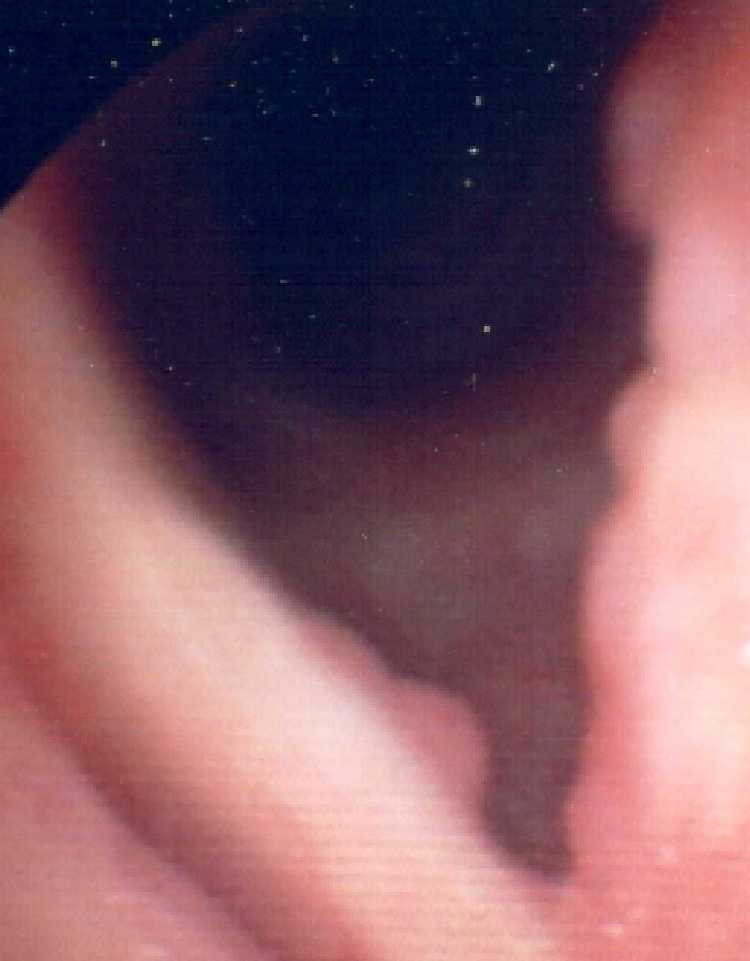
My voice started to deteriorate by late June. I
was able to schedule an appointment for a checkup on 7/14/03. The
image above is from that exam. The two lumps on my right vocal
fold
(left above) have come back and there has been considerable regrowth on
the left fold. I was given two options; PDL treatment without
general
anesthesia and surgery using steel and the PDL under general. In
both cases I would be injected with Cidofovir, the third time for me.
The obvious advantage of PDL only is there is no
general
anesthesia. This is what I have done for the last three
treatments.
After the PDL treatments my voice is very good but not quite as good as
before rrp. The advantage of surgery under general is that the
doctor
can do a much better job of cleaning off the vocal folds. This is
due both to the nature of the PDL only treatment and to the problems I
have with the local anesthesia. Because more of the papilloma
will
be removed this might result in a longer time before I need
treatment
again. Given how erratic this disease is it will be hard to tell
unless it comes back soon. My voice may also be better after
surgery.
I decided on surgery under general anesthesia and I
am
scheduled for 8/13/03. The last time I had surgery under general
they used a different mix and/or timing. I came out without
vomiting
and feeling much better. I hope the results will be the same this
time.
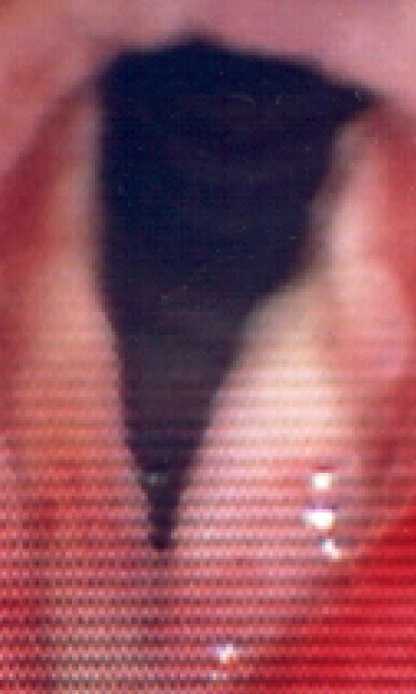
I had surgery on 8/13/03 and then a follow-up exam
on 8/29/03. The image above is from that exam. (The pattern
in the lower part is on the photo I scanned.) The doctor used
cold
steel along with the 585-nm Pulsed Dye Laser to remove the
papilloma. Again I had no problem with the anesthesia this
time. Prior to surgery I discussed my experience with the
anesthesiologist. He said that the difference between the prior
two times was the use of morphine. When I had morphine I was
violently nauseous after surgery.
Surgeries Under General
Anesthesia: 4
Surgeries Under Local
Anesthesia: 3
Interval Since Last Surgery: 23 Weeks
I was on voice rest for two weeks after the surgery. The first
day or so my voice was somewhat rough and tired easily. It is now
9/6/03 and my voice varies from sounding basically normal to breaking
up if I use it too much. My vocal "stamina" is still not what it
was. If I speak
more or less continuously for an extended period of time my voice
starts breaking up intermittently and gets a little sore. I try
to avoid this but I have had some extended meetings at work. I'll
take it easy for the next week or so.
There is a medical paper on the use of the PDL laser under general
anesthesia. It is:
585-nm Pulsed Dye Laser Treatment of Glottal
Papillomatosis
Ramone A. Franco, Jr. MD, Steven M. Zeitels, MD, William A. Farinelli,
R. Rox Anderson, MD
Annals of Otology, Rhinology & Laryngology June 2002 Volume 111
Number 6
A quote from this paper:
"It is readily apparent that PDL treatment offers relief of
tumor burden and minimizes the attendant long-term consequences of
vocal fold scarring that results from repeated surgical ablative
procedures (CO2 laser or cold instruments) required by dissection
within the superficial lamina propria. Because the epithelium is
not fully removed, bilateral treatment of disease is possible.
Anterior commissure disease (medial or internal surface), which is
usually treated with staged operations, can be treated simultaneously,
and thus the number of general anesthetic procedures, with their
attendant morbidity and cost, is minimized.
Clinical observation at the time of PDL therapy revealed that there
were interesting and useful responses of the vocal folds' layered
microstructure to the laser energy. A cleave plane developed at
the epithelial basement membrane in those areas in which the PDL was
used, facilitating an ultraprecise cold instrument resection if that
therapeutic pathway was chosen. This phenomenon has not been
identified in PDL-treated skin, It may be attributable to
denaturation of basement membrane linking proteins that anchor the
epithelium to the superficial lamina propria. In addition there
was enhanced microsurgical precision due to improved hemostasis.
Because the microvasculature was photocoagulated, there was optimal
visualization of the highly magnified tissue planes of the superficial
lamina propria."
In rough translation this says that the use of the PDL in
conjunction with cold steel has a number of advantages:
-It reduces the amount of damage caused by repeated surgeries
-Both vocal folds, even where they join, can be treated at the same
time without causing webbing
-The doctor can be more precise because the PDL coagulates blood and
reduces bleeding which would interfere with the doctor's view.
-The PDL tends to cause the papilloma to separate from the vocal fold
making it easier to accurately remove the papilloma with cold steel
I have found that I need, what I call, my secret decoder
ring to
read medical journal articles. I use Taber's
Cyclopedic Medical Dictionary.
Or you can get Tabers
Electronic Medical Dictionary.
Note that this paper discusses the use of the PDL under general
anesthesia. It does not discuss the use under local anesthesia.
Some time ago I had a couple of visits with a speech
therapist. Unfortunately, shortly after I had a couple of
appointments, the papilloma came back to the point that I needed
treatment again. She lent me a book which includes a CD.
Since I could not
speak after surgery I could not use it and I returned it. However
I picked up a copy and I have started to work through it.
I may then make another appointment with her to make sure that I am
doing things correctly, assuming the papilloma is not back and causing
trouble by then. The book she recommended is Is
Your Voice Telling On You?
I have a follow-up exam scheduled for 9/29/03.
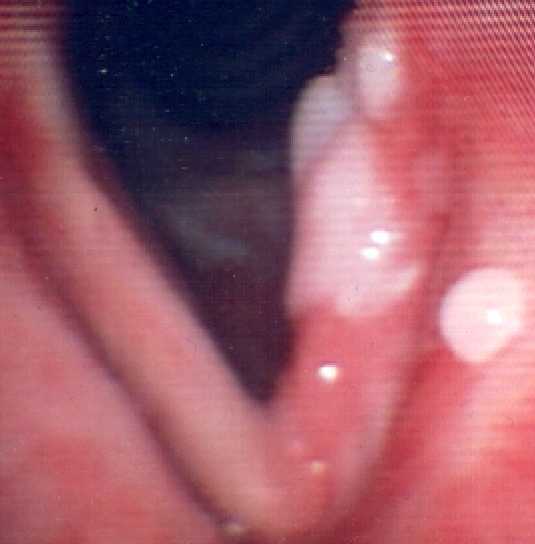
My voice returned almost to normal. The differences are
subtle. My voice does deteriorate more quickly than it did.
The picture above is from a checkup on 9/23/03. As you can see
papilloma has regrown on my left vocal fold and now it has also shown
up on my left false vocal fold. I am scheduled for treatment
under local anesthesia on 10/21 using just the PDL. This time I
plan to get a nerve block in my neck so that the doctor can treat
anywhere that needs it without worrying about pain or gagging.
I'll see how that works. I will also get a Cidofovir
injection. Because my voice is not too bad I could wait longer
for the treatment. However I have been told that the awake PDL
works better if the coverage is not too extensive. Also, the more
the laser is used the more the vocal folds are bruised and the longer
the voice rest must be. I would rather have more frequent 1 week
or less voice rests than less frequent 2 week ones. It disrupts
life and work less.
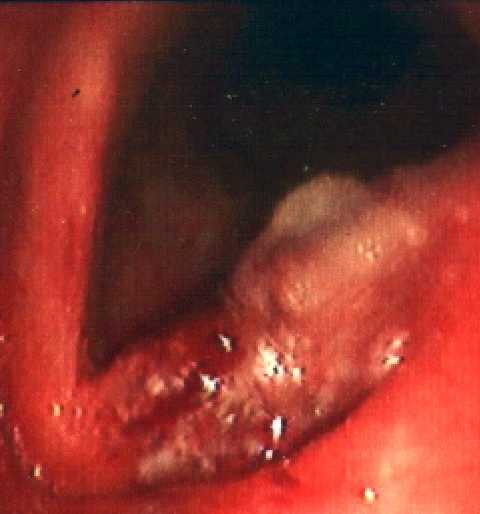
I had surgery again on 10/21/03. This was done under local
anesthesia using the Pulse Dye Laser (PDL). The image above is
from after the treatment. Most of the right vocal fold had
papilloma on it and was treated. I was told to not speak for 5
days.
Surgeries Under General
Anesthesia: 4
Surgeries Under Local
Anesthesia: 4
Interval Since Last Surgery: 10 Weeks
Because I have had a problem in the past
with the inhaled Lidocane spray anesthesia not working well enough I
had a nerve block to do a better job of numbing me up. The nerve
block allowed the doctor to use the PDL as much as was needed. In
some spots I still had some minor pain but I was able to avoid gagging
so the treatment could continue.
I was also injected with Cidofovir. The doctor was not able to
inject as much as he wanted. The nerve block numbed my vocal
folds enough that the injection pain was not a problem. However
the position the scope needed to be held in touched, probably, my soft
palate in such a way that I was unable to avoid gagging. I have
had Cidofovir injected while awake before without this problem. I
am not sure what caused the problem this time. Either the other
doctor who was manipulating the scope held it in a different manner or
the nerve block somehow made other areas more sensitive. I'll
have to discuss this with Dr Franco, Jr. when I have my checkup in
about 3 weeks.
I'll also explain how the nerve block was done. A syringe with a
long thin needle is filled with Lidocane. Injections are done in
4 places, 2 on each side into the neck under the jaw. The needle
is inserted until it hits air in the larynx to get the location and
then it is partially withdrawn while the injections are done.
Several times for each needle it is also wiggled around and pushed in
somewhat, presumably to get a different location. This was
somewhat distressing at the time. Partially due to pain and
partially due to psychological reasons. Getting needles stuck
through your neck just does not seem right! Also, my neck is
quite sore where the injections were done. (I was treated earlier
today.) I am hoping that this will pass soon.
I asked about options to get more effective coverage for the Cidofovir
in the future, other than general anesthesia. One option would be
to inject Cidofovir through the front of the neck into the
larynx. The problem with this is that it would be difficult to
apply it near the surface where it is needed. The second option
would be an additional nerve block going in through somewhere in the
face to numb the soft palate. I would need to think about that
one! The nerve block I had today was considerably worse than I
had expected.
I had a checkup on
11/14/03. I do not have pictures. While my vocal folds were
not back to their "normal" state they looked OK and I could speak well.
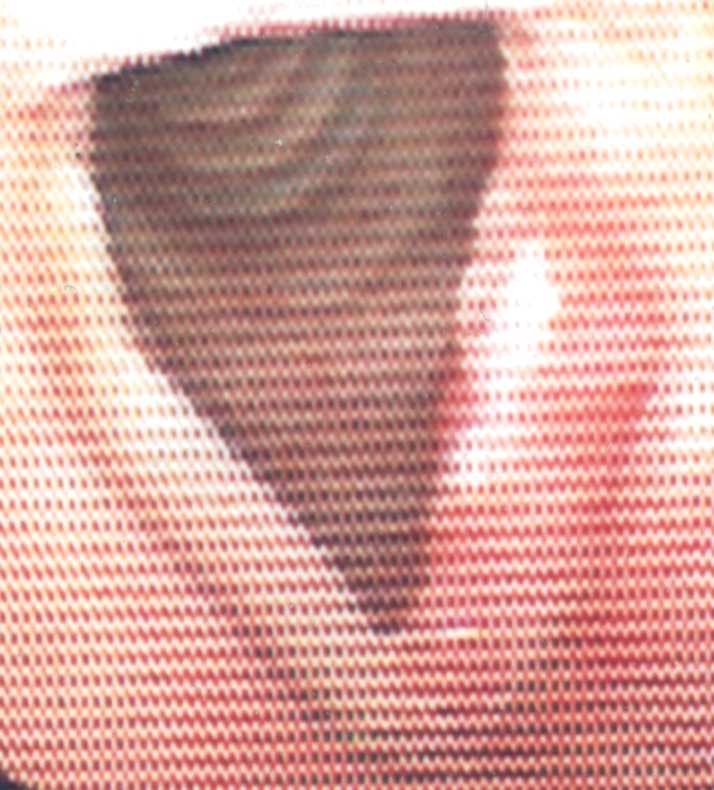
I had a checkup on 12/22/03. The picture quality above makes it
hard to see but my left vocal fold, right above, is larger than the
right and there are two small bumps of regrowth towards the top.
This is a location which has tended to have growth. This is two
months since my last treatment, there is little regrowth, and my voice
works well. The growth seems to have slowed. I don't know
if this is due to the Cidofovir injections, to taking I3C, or
luck. In any case I am glad to be able to speak!
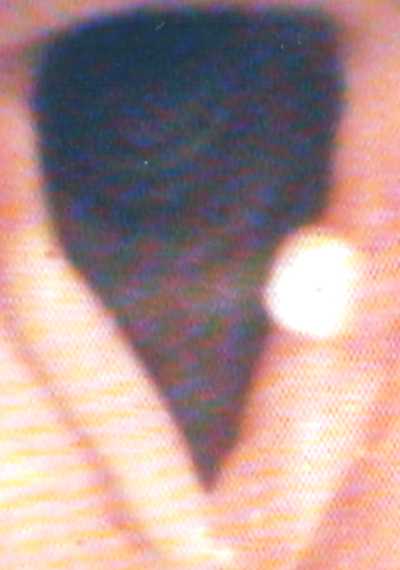
I had a checkup on 2/9/04. The doctor said that the large white
lump on my left vocal fold is a granuloma. It is too white to be
papilloma. He said that it was probably caused by irritation at a
site where papilloma was removed. The more or less even layer of
papilloma on the left vocal fold is not significantly changed from last
time. It appears that the papilloma is growing little if at all.
My voice is working pretty well. I only have problems if I have
to speak for a long time. Even then I can manage it by sipping
water and taking it a little easy. As long as it is not
significantly interfering with my voice I'll wait to do anything about
the granuloma. The papilloma will almost certainly come back
sometime and the granuloma can be dealt with then.
I had a checkup on
4/9/04. No pictures were taken. There appears to be no
papilloma growth and the granuloma seen above has come off. My
left vocal fold, right above, is still thicker than it used to be but
my voice is quite functional. I can't sing as will as I could
before this all started but I couldn't sing very well in any case so it
is not a real loss. I have a checkup in July.
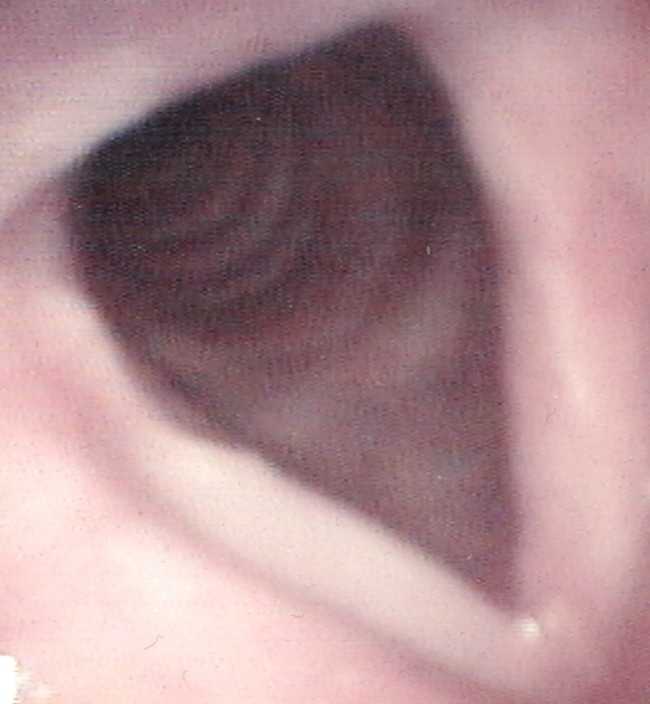
I had a checkup on 7/9/04. There still appears to be
no papilloma growth. The granuloma is still gone. My voice
is fine. I have a checkup scheduled in January.
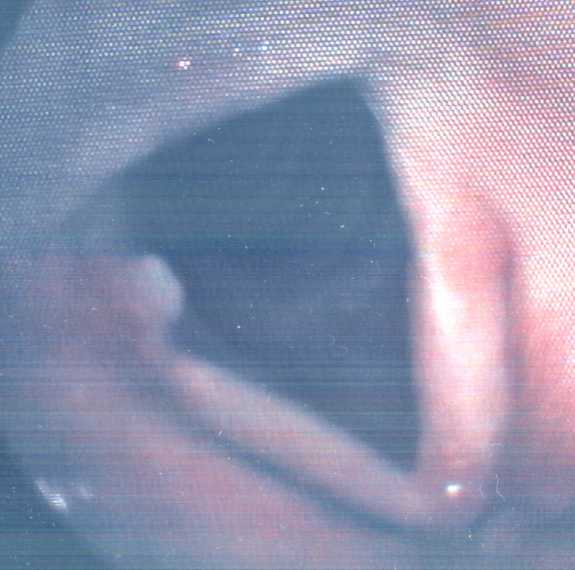
I had a checkup on 1/16/05. There still appears to be no
papilloma growth. I have a new granuloma above the right vocal
fold. This is in an area that does not interfere significantly
with my voice. At this time we will leave this alone. I
have another checkup scheduled in about 6 months.
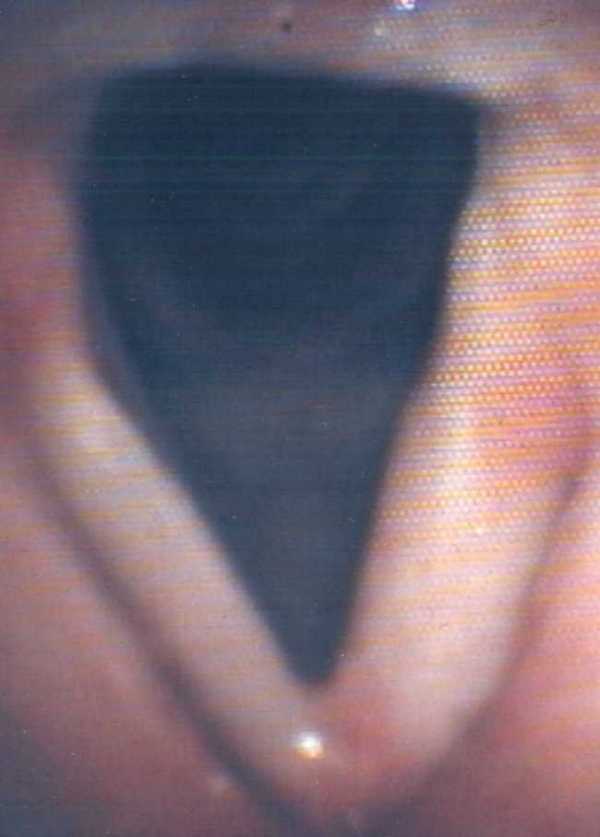
I had a checkup on 9/19/05. The granuloma that
was above the right vocal fold is gone. There appears to be some
papilloma on my left vocal fold but there does not appear to have been
any additional growth since my last checkup. My voice has not
changed. I
have another checkup scheduled in about 9 months.
I have had a bit of a sore throat on and off for the last 6
weeks. I asked Dr Franco about this. I suggested that it
might be due to post nasal drip caused by seasonal allergies. He
said that might be the case and that it might also be due either to
some
irritation from the papilloma I have or from acid reflux. He
suggested that I take Prilosec OTC. If it is going to help he
said that I should see a noticeable improvement within 4-6 weeks.
I plan to wait till a month or so after we get our first good hard
frost. I live in NH and that should stop the plants that cause me
some problems. If that does not help I'll try the Prilosec OTC.
On the rrpf group someone asked me about the amount of Cidofovir I
received. Questions were also raised about side effects from
Cidofovir. I asked the doctor about that.
He uses a concentration of 25mg/cc of
Cidofovir. He injects it into the papillomas. The total
amount
injected depends on the amount of papilloma and how much he can get
in. When done under local it also depended on how well the local
worked
and how much I could tolerate. The total amounts injected for my
5
treatments varied from 5-25mg of Cidofovir.
He also said that although he has never had any of his patients
experience side effects from Cidofovir it is possible, although
extremely rare, to get them even with injections limited to the
papillomas. The side effects typically effect the kidneys.
A quick search turned up the following info from the NIH on Cidofovir
http://www.nlm.nih.gov/medlineplus/druginfo/medmaster/a696037.html
Note that this is about the drug delivered in an IV drip which, as I
understand it, is much more
likely to cause problems than injection in
the papillomas.
Given the risks involved in having repeated surgeries and the problems
rrp causes I have decided that taking Cidofovir is the lesser risk and
is worth it. Everyone has to make their own decision based on the
limited amount of information available.
10/15/2008
I have been getting questions about my current status. I am still in remission. I have had no further checkups. I may go sometime soon just to make sure there has been no growth that is not effecting my voice.
Note I am not a doctor and I am not giving medical advice. I am
just
describing the experiences and thoughts I have had.
Contact:
tony@lekas.org





















